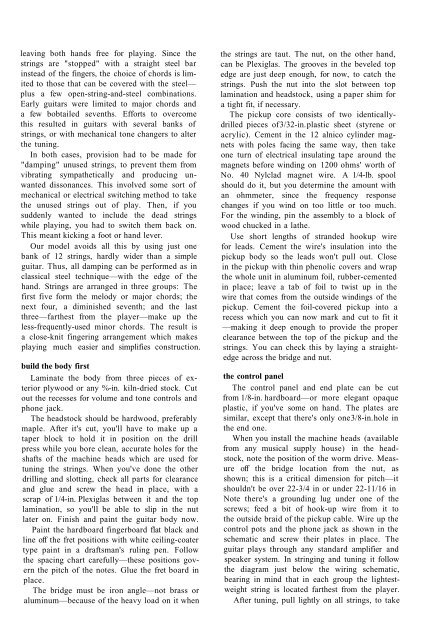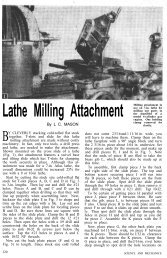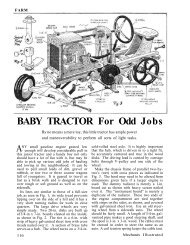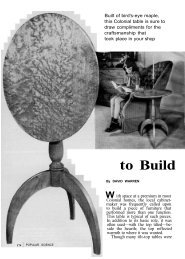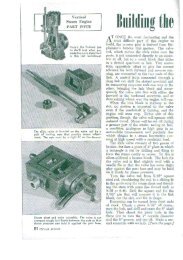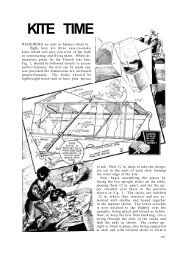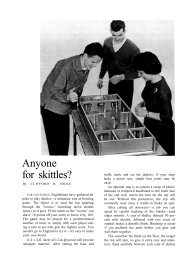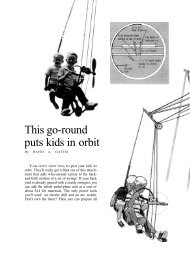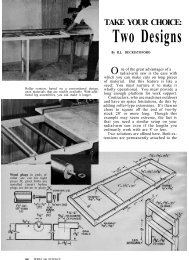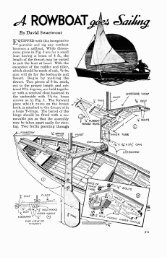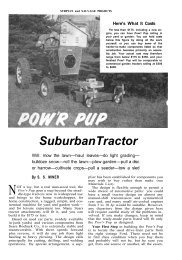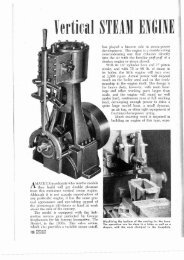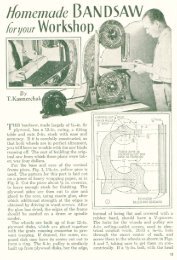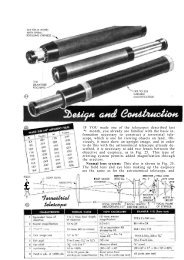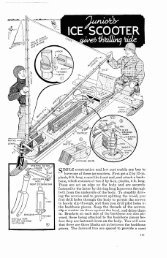Build a singing steel guitar - Vintage Projects
Build a singing steel guitar - Vintage Projects
Build a singing steel guitar - Vintage Projects
You also want an ePaper? Increase the reach of your titles
YUMPU automatically turns print PDFs into web optimized ePapers that Google loves.
leaving both hands free for playing. Since the<br />
strings are "stopped" with a straight <strong>steel</strong> bar<br />
instead of the fingers, the choice of chords is limited<br />
to those that can be covered with the <strong>steel</strong>—<br />
plus a few open-string-and-<strong>steel</strong> combinations.<br />
Early <strong>guitar</strong>s were limited to major chords and<br />
a few bobtailed sevenths. Efforts to overcome<br />
this resulted in <strong>guitar</strong>s with several banks of<br />
strings, or with mechanical tone changers to alter<br />
the tuning.<br />
In both cases, provision had to be made for<br />
"damping" unused strings, to prevent them from<br />
vibrating sympathetically and producing unwanted<br />
dissonances. This involved some sort of<br />
mechanical or electrical switching method to take<br />
the unused strings out of play. Then, if you<br />
suddenly wanted to include the dead strings<br />
while playing, you had to switch them back on.<br />
This meant kicking a foot or hand lever.<br />
Our model avoids all this by using just one<br />
bank of 12 strings, hardly wider than a simple<br />
<strong>guitar</strong>. Thus, all damping can be performed as in<br />
classical <strong>steel</strong> technique—with the edge of the<br />
hand. Strings are arranged in three groups: The<br />
first five form the melody or major chords; the<br />
next four, a diminished seventh; and the last<br />
three—farthest from the player—make up the<br />
less-frequently-used minor chords. The result is<br />
a close-knit fingering arrangement which makes<br />
playing much easier and simplifies construction.<br />
build the body first<br />
Laminate the body from three pieces of exterior<br />
plywood or any %-in. kiln-dried stock. Cut<br />
out the recesses for volume and tone controls and<br />
phone jack.<br />
The headstock should be hardwood, preferably<br />
maple. After it's cut, you'll have to make up a<br />
taper block to hold it in position on the drill<br />
press while you bore clean, accurate holes for the<br />
shafts of the machine heads which are used for<br />
tuning the strings. When you've done the other<br />
drilling and slotting, check all parts for clearance<br />
and glue and screw the head in place, with a<br />
scrap of 1/4-in. Plexiglas between it and the top<br />
lamination, so you'll be able to slip in the nut<br />
later on. Finish and paint the <strong>guitar</strong> body now.<br />
Paint the hardboard fingerboard flat black and<br />
line off the fret positions with white ceiling-coater<br />
type paint in a draftsman's ruling pen. Follow<br />
the spacing chart carefully—these positions govern<br />
the pitch of the notes. Glue the fret board in<br />
place.<br />
The bridge must be iron angle—not brass or<br />
aluminum—because of the heavy load on it when<br />
the strings are taut. The nut, on the other hand,<br />
can be Plexiglas. The grooves in the beveled top<br />
edge are just deep enough, for now, to catch the<br />
strings. Push the nut into the slot between top<br />
lamination and headstock, using a paper shim for<br />
a tight fit, if necessary.<br />
The pickup core consists of two identicallydrilled<br />
pieces of 3/32-in. plastic sheet (styrene or<br />
acrylic). Cement in the 12 alnico cylinder magnets<br />
with poles facing the same way, then take<br />
one turn of electrical insulating tape around the<br />
magnets before winding on 1200 ohms' worth of<br />
No. 40 Nylclad magnet wire. A 1/4-lb. spool<br />
should do it, but you determine the amount with<br />
an ohmmeter, since the frequency response<br />
changes if you wind on too little or too much.<br />
For the winding, pin the assembly to a block of<br />
wood chucked in a lathe.<br />
Use short lengths of stranded hookup wire<br />
for leads. Cement the wire's insulation into the<br />
pickup body so the leads won't pull out. Close<br />
in the pickup with thin phenolic covers and wrap<br />
the whole unit in aluminum foil, rubber-cemented<br />
in place; leave a tab of foil to twist up in the<br />
wire that comes from the outside windings of the<br />
pickup. Cement the foil-covered pickup into a<br />
recess which you can now mark and cut to fit it<br />
—making it deep enough to provide the proper<br />
clearance between the top of the pickup and the<br />
strings. You can check this by laying a straightedge<br />
across the bridge and nut.<br />
the control panel<br />
The control panel and end plate can be cut<br />
from 1/8-in. hardboard—or more elegant opaque<br />
plastic, if you've some on hand. The plates are<br />
similar, except that there's only one 3/8-in. hole in<br />
the end one.<br />
When you install the machine heads (available<br />
from any musical supply house) in the headstock,<br />
note the position of the worm drive. Measure<br />
off the bridge location from the nut, as<br />
shown; this is a critical dimension for pitch—it<br />
shouldn't be over 22-3/4 in or under 22-11/16 in<br />
Note there's a grounding lug under one of the<br />
screws; feed a bit of hook-up wire from it to<br />
the outside braid of the pickup cable. Wire up the<br />
control pots and the phone jack as shown in the<br />
schematic and screw their plates in place. The<br />
<strong>guitar</strong> plays through any standard amplifier and<br />
speaker system. In stringing and tuning it follow<br />
the diagram just below the wiring schematic,<br />
bearing in mind that in each group the lightestweight<br />
string is located farthest from the player.<br />
After tuning, pull lightly on all strings, to take


